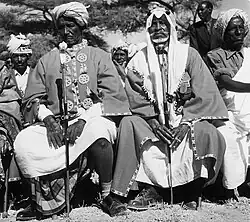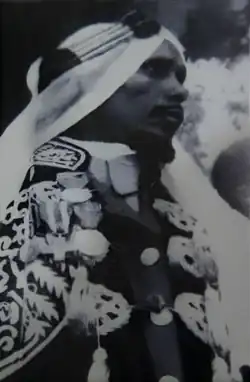Ajuran (clan)
| Ajuran اجوران | |
|---|---|
| Hawiye Somali clan | |
 Flag of the Ajuran Sultanate | |
| Ethnicity | |
| Location | |
| Descended from | Sheikh Ahmed Bin Abdulrahman Bin Uthman |
| Parent tribe | Hawiye |
| Language | |
| Religion | Sunni Islam |
 |
| Part of a series on |
| Somali clans |
|---|

The Ajuran (Somali: Ajuuraan, Beesha Ajuuraan, Morshe, Arabic: أجوران) is a Somali clan, part of the Jambelle clan which itself belongs to the largest Somali clan-family — the Hawiye.[1][2] Ajuran members largely inhabit Kenya as well as southern east Ethiopia; considerable numbers are also found in southern Somalia.[3][4] Some Ajuran members are settled in Mogadishu.[5][6]
Overview
The Ajuran clan's origins are found in the Ajuran Sultanate, a Somali Muslim sultanate that ruled over large parts of the Horn of Africa in the Middle Ages.[7][8][9] Today they largely live in the North Eastern Province in Kenya and the Somali region of Ethiopia, but also in Somalia. The Ajuran primarily speak the Somali language.[10]
The Ajuran are said to be part of the Jambelle Hawiye[11][12][13][14] but were displaced from modern Hawiye territories in the late 17th to early 18th centuries due to historical conflicts particularly in South Central Somalia.[11][15][16][17] According to Günther, their descent is maternal from Faduma, daughter of Jambelle. Although the father is not explicitly mentioned in this version.[18][19]. However, as common as it is to find multiple lineages with elaborate stories of founding genealogies via trees and wells for clans and even ethnic groups due to pre-eminence, much like some Isaaq traditions of claiming a maternal affinity with the Dir despite the Dir traditions of Isaaq being a paternal descent, the Ajuran are said to be Hawiye by paternal descent according to several Hawiye traditions as confirmed by Mohamed Ibrahim Liqliiqato and Colonial explorers who visited the Kelafo region such as Luigi Robecci Bricchetti.[20][21][22]
Lee Cassanelli in his 1982 book "The Shaping of Somali Society: Reconstructing the History of a Pastoral People, 1600-1900" often refers to the Ajuran as former leaders of a Hawiye clan dynasty.[23]
History
Antiquity
Many traditions link the Ajuran with a people known to the Somalis as Madanle (Maantiiinle. Madinle, etc.) who were celebrated well-diggers in southern Somalia and northeastern Kenya.[24]
Ajuran Empire
The Ajuran clan established the Garen Dynasty that ruled both Mogadishu Sultanate and Ajuran Sultanate during the Middle Ages.[25]
Early Modern Period
During the early modern period, in the 19th century, under Sultan Olol Dinle, the Ajuran Sultanate was almost revived. He was described as the "Sultan of Sciavelli (Shabelle) and Auia (Hawiye)" in the early 1930s.[26] Not long after would Olol Dinle be accused of conspiring with the Italians against the Ethiopian government. He was assassinated by Haile Salassie in 1960.[27][28]
Language
The Ajuran in Somalia normally speak standard Somali while those in the riverside communities of Hirshabelle speak Maay Maay. As for the Ajuran in Kenya, the linguistic case is more complex. The Wallemugge section are often bilingual in Somali and Borana.[29][30] However most sources state that Somali is the dominant language in the North Eastern Province, so bilingual speakers are many among the Ajuran who live in Moyale where the Borana language is prevalent.[30][31]
Clan Tree
This Clan Tree is based on "The Total Somali Clan Genealogy (second edition)" by Abbink, G.J.[32]
- Hill
Notable people
- Faduma Sarjelle, princess
- Dhaqsoore. House of Gareen member
- Rasul ibn Ali, sultan
References
- ^ Musau, Stephen (December 2013). Somalia, Clan and State Politics. ITPCM. p. 14.
- ^ M. Anderson, David; H. Rolandsen, Øystein (eds.). "Remembering Wagalla: state violence in northern Kenya, 1962–1991". Politics and Violence in Eastern Africa The Struggles of Emerging States.
- ^ Mohamed Haji Mukhtar (25 February 2003). Historical Dictionary of Somalia. Scarecrow Press. p. 35. ISBN 978-0-8108-6604-1.
- ^ Kenya National Assembly Official Record (Hansard). 1984-03-20.
- ^ Gebrewold, Belachew (2016-04-15). Anatomy of Violence: Understanding the Systems of Conflict and Violence in Africa. Routledge. ISBN 978-1-317-18139-2.
- ^ Butcher, Charity (2019-04-16). The Handbook of Cross-Border Ethnic and Religious Affinities. Rowman & Littlefield. ISBN 978-1-4422-5022-2.
- ^ Luling, Virginia (2002). Somali Sultanate: the Geledi city-state over 150 years. Transaction Publishers. p. 17. ISBN 978-1-874209-98-0.
- ^ Luc Cambrézy, Populations réfugiées: de l'exil au retour, p.316
- ^ Mukhtar, Mohamed Haji (1989). "The Emergence and Role of Political Parties in the Inter-River Region of Somalia from 1947–1960". Ufahamu. 17 (2): 98. doi:10.5070/F7172016882.
- ^ Schlee, Günther; Watson, Elizabeth E. (2009-01-01). Changing Identifications and Alliances in North-East Africa. Berghahn Books. ISBN 9781845456030.
- ^ a b Abbink, Jon (1999). The Total Somali clan Geneaology. p. 1.
- ^ Geographica Italiana, Società (1892). Bollettino della Società geografica italiana.
- ^ Liiqliiqato, Maxamed (1986). Taariikhda Soomaaliya dalkii filka weynaa ee punt. p. 18.
- ^ Ahmed, Ali Jimale, ed. (1995). The invention of Somalia. Lawrenceville, NJ: Red Sea Press. p. 134. ISBN 978-0-932415-98-1.
- ^ Brelvi, Mahmud (1964). Islam in Africa. p. 189.
- ^ Nelson, Harold (1982). Somalia a country study. p. 11.
- ^ Foreign Affairs, Ministry of (1967). Somali Kenya relations in True Perspective. p. 15.
- ^ Schlee, Günther (1989). Identities on the move: clanship and pastoralism in Northern Kenya (PDF). International African library. Manchester: Manchester university press. pp. 28, 227. ISBN 978-0-7190-3010-9.
The Ajuran, who are often referred to as Hawiyya, claim to descend from Fadumo daughter of Jambelle son of Hawiyya. Cerulli reports a story about the origin of the Ajuran in which the sons of Hawiyya found the Ajuran's father in a tree and had to persuade him to come down, promising him, among other things, their sister. Ajuran, Alama, Bal'ad, Edimole, Kaale, Faas, Harmalle, Shimaal, Aqil, Abu Talib, Abdu-l-Muttalib
- ^ Ahmed, Ali Jimale, ed. (1995). The invention of Somalia. Lawrenceville, NJ: Red Sea Press. p. 119. ISBN 978-0-932415-98-1.
- ^ Liqliqato, Mohamed Ibrahim (1994). Taariikhda Soomaaliya dalkii filka weynaa ee punt. p. 18.
- ^ Bricchetti, Luigi (1891). Somalia e Benadir. p. 19.
- ^ Bricchetti, Luigi (1891). Somalia e Benadir. p. 18.|quote=The Giambelle Auija almost no longer exist: only a few from the Agiuran (Higuiuran) tribe remain who are their descendants. According to one tradition, their leader Giambelle left no other descendants than a woman who bore a son to a man named Agiuran. Other traditions say that their chief Giambelle left a son named Allame, who begot Agiuran, and thus they would have followed in succession: Agiuran Allame, Ullalmoghe, Cunle, Adeg, Garsore, Coren, Dail, Sergiel, Eljarre, Eldafen, Samajeci
- ^ de recherche en afrique, institut francais (1993). IFRA Nairobi relations. p. 25.
- ^ Schlee, Günther (2018-09-03). Identities on the Move. doi:10.4324/9780429444050. ISBN 9780429444050. S2CID 128552150.
- ^ Lewis, I. M. (2019-05-20). A Modern History Of Somalia: Nation And State In The Horn Of Africa, Revised, Updated, And Expanded Edition. Routledge. ISBN 978-0-429-71282-1.
- ^ Mondadori, Arnoldo (1941). Gli annali dell'Africa italiana Volume 4. Italian East Africa. p. 345.
- ^ Khalif, Mohamud H.; Doornbos, Martin (2002-03-01). "The Somali region in ethiopia: a neglected human rights tragedy". Review of African Political Economy. 29 (91). doi:10.1080/03056240208704585. ISSN 0305-6244.
- ^ Ali, Abdulkadir (2023-12-04). The Covert Genocide: Tragedy of a Nation Downtrodden. Fulton Books, Inc. ISBN 979-8-88731-671-0.
- ^ B.W, ANDRZEJEWSKI (1974). Note of the Linguistic Situation of the Somali and Galla in Kenya.
- ^ a b Islam and Ethnicity in Northern Kenya and Southern Ethiopia, Pax Boranica G.H.Schlee
- ^ Bulle, Nathalie; Iorio, Francesco Di (2023-12-28). The Palgrave Handbook of Methodological Individualism: Volume II. Springer Nature. p. 320. ISBN 978-3-031-41508-1.
- ^ G.J., Abbink (2009). The Total Somali Clan Genealogy (second ed.). pp. 10, 31.
{{cite book}}:|work=ignored (help)
Sources
- Mukhtar, Mohamed Haji (2003). Historical Dictionary of Somalia. Scarecrow Press. ISBN 978-0-8108-6604-1.
- Lewis, Ioan M. (1994). Blood and Bone: The Call of Kinship in Somali Society. Lawrencewill, NJ: The Red Sea Press. ISBN 0-932415-93-8.